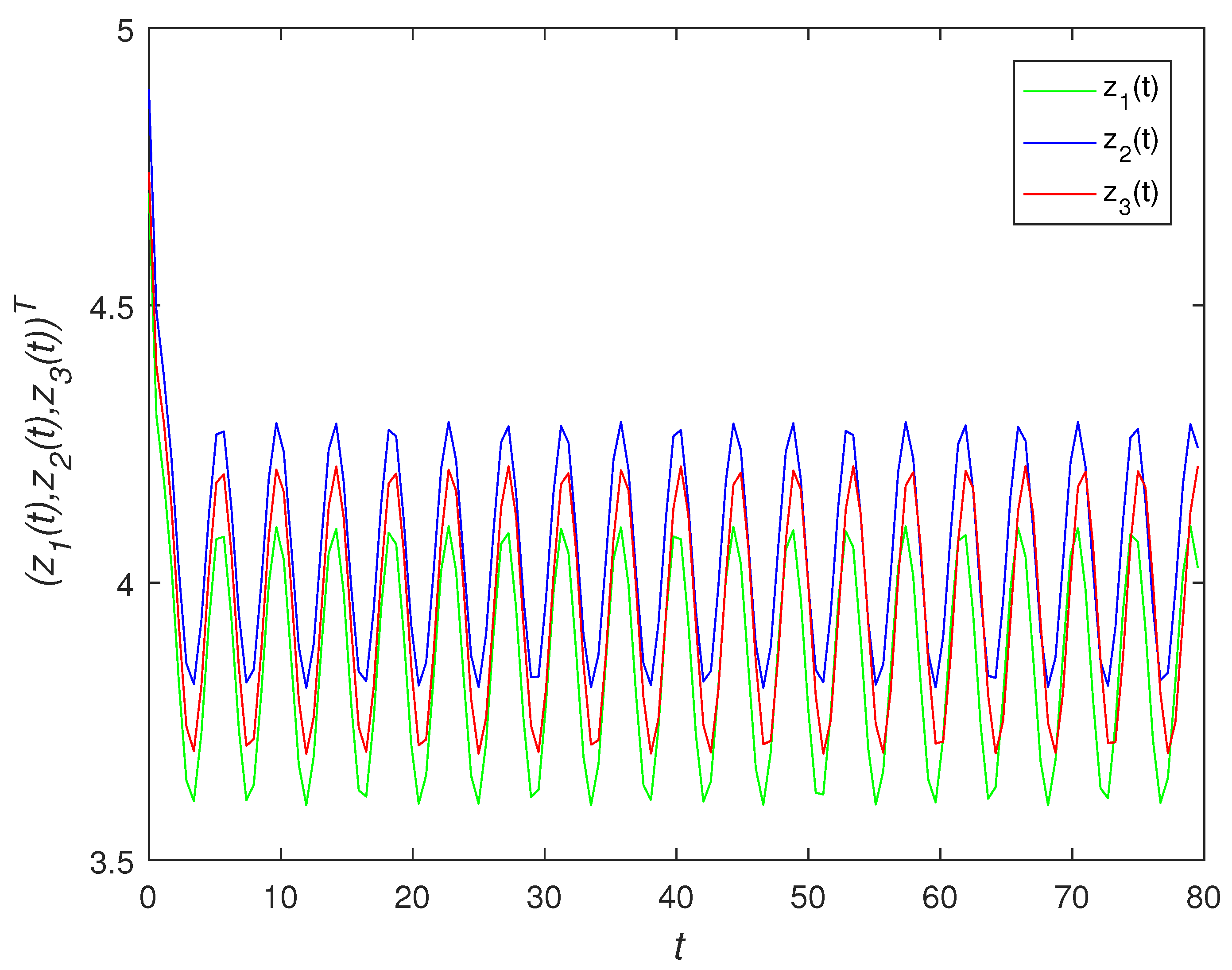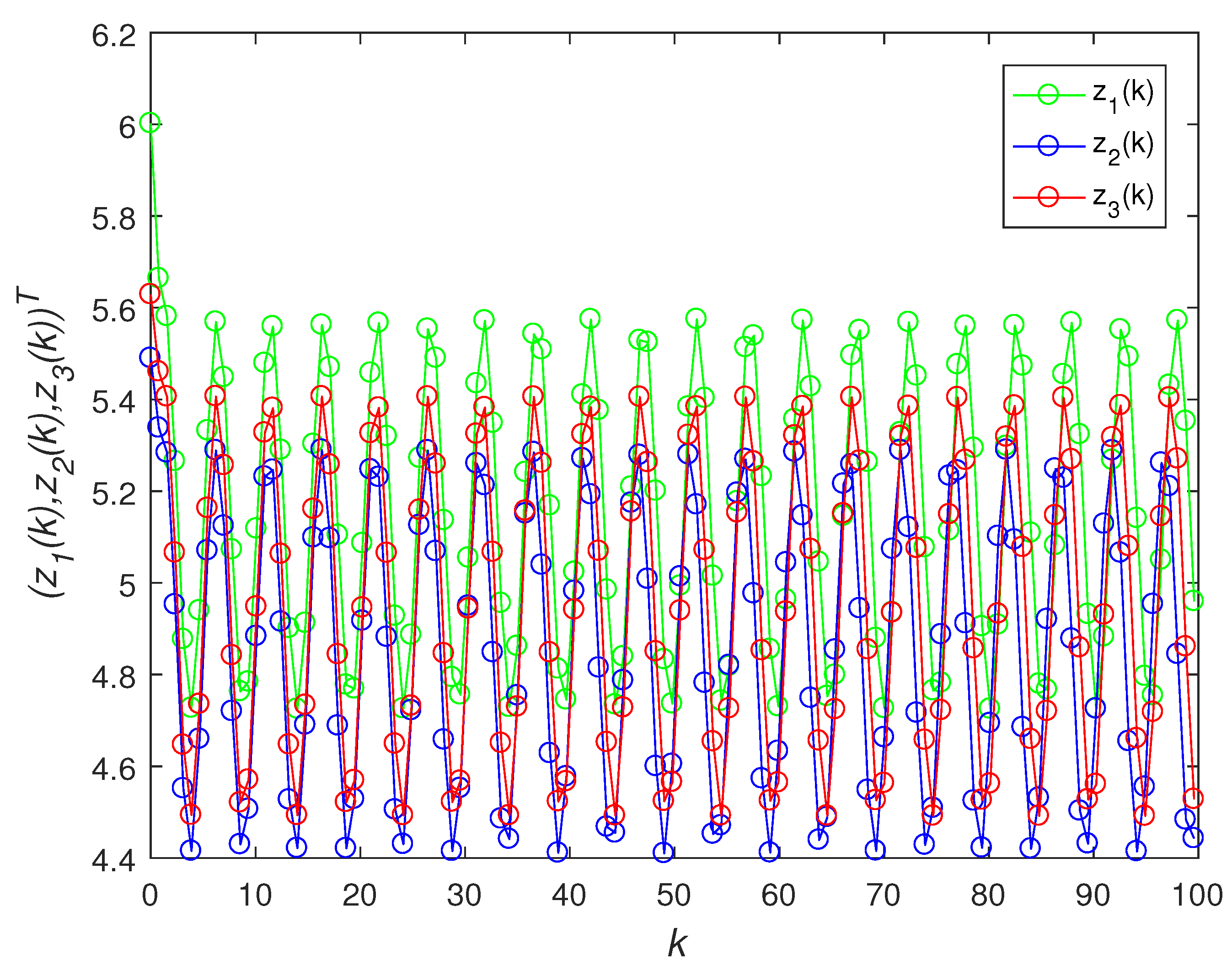Positive Periodic Solutions of Non-Autonomous Predator-Prey System with Stage-Structured Predator on Time Scales
Abstract
1. Introduction
- (1)
- We first consider a predator-prey system with stage-structured predator on time scales and obtain the existence of positive periodic solutions which are general positive functions, which is different from corresponding ones in [1].
- (2)
- We develop Schauder’s fixed-point theorem for investigating dynamic systems on time scales.
- (3)
- System (3) unifies discrete and continuous systems which can improve and generalize the existing results.
2. Preliminaries
3. Existence of Positive Periodic Solutions
4. Asymptotic Property of Positive Periodic Solutions
5. An Example
6. Conclusions
Author Contributions
Funding
Data Availability Statement
Conflicts of Interest
References
- Zeng, Z. Periodic solutions for a delayed predator-prey system with stage-structured predator on time scales. Comput. Math. Appl. 2011, 61, 3298–3311. [Google Scholar] [CrossRef]
- Zhang, K.; Yu, C.; Wang, H.; Li, X. Multiscale Effects of Predator-Prey Systems with Holling-III Functional Response. Int. J. Bifurc. Chaos 2024, 34, 2450072. [Google Scholar] [CrossRef]
- Souna, F.; Tiwari, P.; Menacer, B. A predator-prey system with prey social behavior and generalized Holling III functional response: Role of predator-taxis on spatial patterns. Math. Methods Appl. Sci. 2023, 46, 13991–14006. [Google Scholar] [CrossRef]
- Skalski, G.; Gilliam, J. Functional responses with predator interference: Viable alternatives to the Holling II model. Ecology 2001, 82, 3083–3092. [Google Scholar] [CrossRef]
- Lv, Y.; Du, Z. Existence and global attractivity of a positive periodic solution to a Lotka-Volterra model with mutual interference and Holling III type functional response. Nonlinear Anal. Real World Appl. 2011, 12, 3654–3664. [Google Scholar] [CrossRef]
- Yousef, A.; Rida, S.; Arafat, S. Analytical bifurcation behaviors of a host-parasitoid model with Holling type III functional response. J. Egypt. Math. Soc. 2023, 31, 2. [Google Scholar] [CrossRef]
- Yan, X.; Zhang, C. Spatiotemporal Dynamics in a Diffusive Predator-Prey System with Beddington-DeAngelis Functional Response. Qual. Theory Dyn. Syst. 2022, 21, 166–214. [Google Scholar] [CrossRef]
- Mulugeta, B.; Yu, L.; Yuan, Q.; Ren, J. Bifurcation analysis of a predator-prey model with strong Allee effect and Beddington-DeAngelis functional response. Discret. Contin. Dyn. Syst. Ser. 2023, 28, 1938–1963. [Google Scholar] [CrossRef]
- Luo, D.; Wang, Q. Global bifurcation for a Beddington-DeAngelis and Tanner predator-prey reaction-diffusion system with prey-taxis. Math. Methods Appl. Sci. 2024, 47, 1711–1727. [Google Scholar] [CrossRef]
- Yang, J. Persistence and periodic measure of a stochastic predator-prey model with Beddington-DeAngelis functional response. Int. J. Biomath. 2023, 16, 2250116. [Google Scholar] [CrossRef]
- Lin, G.; Hong, Y. Delay induced oscillation in predator-prey system with Beddington-DeAngelis functional response. Appl. Math. Comput. 2007, 190, 1296–1311. [Google Scholar] [CrossRef]
- Gourley, S.; Kuang, Y. A stage structured predator-prey model and its dependence on through-stage delay and death rate. J. Math. Biol. 2004, 49, 188–200. [Google Scholar] [CrossRef] [PubMed]
- Kar, T.; Pahar, U. Modelling and analysis of a prey-predator system with stage-structure and harvesting. Nonlinear Anal. RWA 2007, 8, 601–609. [Google Scholar] [CrossRef]
- Song, X.; Chen, L. Modelling and analysis of a single species system with stage structure and harvesting, Math. Comput. Modelling 2002, 36, 67–82. [Google Scholar]
- Li, J.; Liu, X.; Wei, C. The impact of role reversal on the dynamics of predator-prey model with stage structure. Appl. Math. Model. 2022, 104, 339–357. [Google Scholar] [CrossRef]
- Wang, W.; Chen, L. A predator-prey system with stage-structure for predator. Comput. Math. Appl. 1997, 33, 83–91. [Google Scholar] [CrossRef]
- Fang, H.; Wang, Y. Four periodic solutions for a food-limited twospecies Gilpin-Ayala type predator-prey system with harvesting terms on time scales. Adv. Differ. Eq. 2013, 1, 278. [Google Scholar] [CrossRef]
- Chen, X. Periodicity in a nonlinear predator-prey system on time scales with state-dependent delays. Appl. Math. Comput. 2008, 196, 118–128. [Google Scholar] [CrossRef]
- Kumar, A.; Malik, M.; Kang, Y. Dynamics for a hybrid non-autonomous prey-predator system with generalist predator and impulsive conditions on time scales. Int. J. Biomath. 2023, 16, 2250067. [Google Scholar] [CrossRef]
- Yun, K.; Wedekin, L. Dynamics of a intraguild predation model with generalist or specialist predator. J. Math. Biol. 2013, 5, 18932589. [Google Scholar]
- Lakshmikantham, V.; Vatsala, A. Hybrid system on time scales. J. Comput. Appl. Math. 2002, 141, 227–235. [Google Scholar] [CrossRef]
- Bohner, M.; Peterson, A. Dynamic Equations on Time Scales, An Introduction with Applications; Birkhäuser Boston: Cambridge, MA, USA, 2001. [Google Scholar]
- Kaufmann, E.; Raffoul, Y. Periodic solutions for a neutral nonlinear dynamical equation on a time scale. J. Math. Anal. Appl. 2006, 319, 315–325. [Google Scholar] [CrossRef]
- Adivar, M.; Bohner, E. Halanay type inequalities on time scales with applications. Nonlinear Anal. 2011, 74, 7519–7531. [Google Scholar] [CrossRef][Green Version]
- Smart, D. Fixed Points Theorems; Cambridge University Press: Cambridge, UK, 1980. [Google Scholar]
- Ardjouni, A.; Djoudi, A. Existence of periodic solutions for nonlinear neutral dynamic equations with variable delay on a time scale, Commun. Nonlinear Sci. Numer. Simulat. 2012, 17, 3061–3069. [Google Scholar] [CrossRef]


Disclaimer/Publisher’s Note: The statements, opinions and data contained in all publications are solely those of the individual author(s) and contributor(s) and not of MDPI and/or the editor(s). MDPI and/or the editor(s) disclaim responsibility for any injury to people or property resulting from any ideas, methods, instructions or products referred to in the content. |
© 2025 by the authors. Licensee MDPI, Basel, Switzerland. This article is an open access article distributed under the terms and conditions of the Creative Commons Attribution (CC BY) license (https://creativecommons.org/licenses/by/4.0/).
Share and Cite
Ge, J.; Li, X.; Du, B.; Wang, T. Positive Periodic Solutions of Non-Autonomous Predator-Prey System with Stage-Structured Predator on Time Scales. Symmetry 2025, 17, 86. https://doi.org/10.3390/sym17010086
Ge J, Li X, Du B, Wang T. Positive Periodic Solutions of Non-Autonomous Predator-Prey System with Stage-Structured Predator on Time Scales. Symmetry. 2025; 17(1):86. https://doi.org/10.3390/sym17010086
Chicago/Turabian StyleGe, Jing, Xiaoliang Li, Bo Du, and Tao Wang. 2025. "Positive Periodic Solutions of Non-Autonomous Predator-Prey System with Stage-Structured Predator on Time Scales" Symmetry 17, no. 1: 86. https://doi.org/10.3390/sym17010086
APA StyleGe, J., Li, X., Du, B., & Wang, T. (2025). Positive Periodic Solutions of Non-Autonomous Predator-Prey System with Stage-Structured Predator on Time Scales. Symmetry, 17(1), 86. https://doi.org/10.3390/sym17010086






